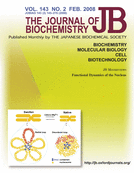-
Views
-
Cite
Cite
Silvia Meneghelli, Laura Luoni, Maria Ida De Michelis, Heparin Stimulates a Plasma Membrane Ca2+-ATPase of Arabidopsis thaliana, The Journal of Biochemistry, Volume 143, Issue 2, February 2008, Pages 253–259, https://doi.org/10.1093/jb/mvm218
Close - Share Icon Share
Abstract
We have studied the effect of heparin, a glycosaminoglycan widely used in releasing tags from fusion proteins, on isoform 8 of Arabidopsis thaliana PM Ca2+-ATPase (ACA8) expressed in Saccharomyces cerevisiae strain K616. Heparin stimulates hydrolytic activity of ACA8 with an estimated K0.5 value for the complex of 15 ± 1 µg ml−1, which is unaffected by free [Ca2+]. Heparin increases Vmax up to 3-fold while it does not significantly affect the apparent Km for free Ca2+ and for the nucleoside triphosphate substrate. The heparin effect is not additive with that of exogenous calmodulin and heparin is ineffective on a mutant devoid of the N-terminal auto-inhibitory domain (Δ74–ACA8). Altogether, these results indicate that heparin activation is due to partial suppression of the auto-inhibitory function of ACA8 N-terminus. Pull-down assays using heparin–agarose gel show that heparin directly interacts with ACA8. Binding to the heparin–agarose gel occurs also with a peptide reproducing ACA8 sequence 1M-I116. Several single-point mutations within ACA8 sequence A56–T63 significantly alter the enzyme response to heparin, suggesting that heparin interaction with this site may be involved in ACA8 activation. These results highlight a new difference between the plant PM Ca2+-ATPase and its animal counterpart, which is inhibited by heparin.





